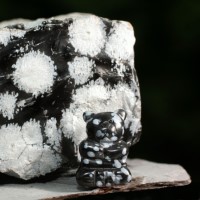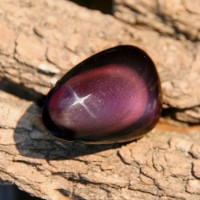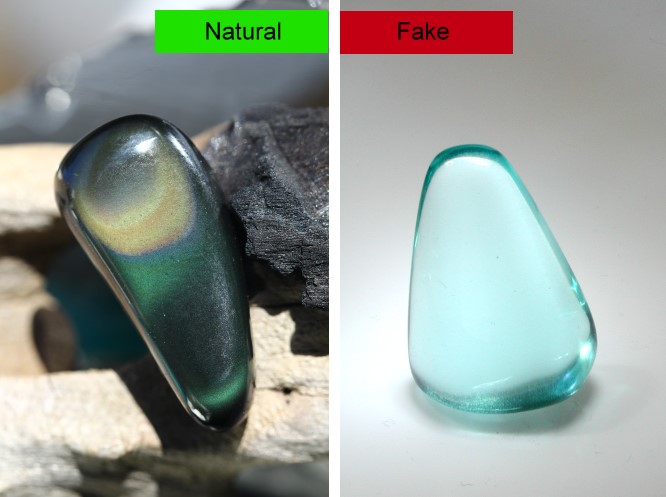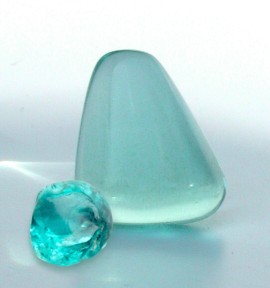Obsidian is a volcanic rock, whose chemical composition corresponds to that of rhyolitic or granitic rocks. It is formed during volcanic eruptions when silicic lava cools down very quickly in air or water. Because of a rapid cooling process the volcanic melt hardly had time to crystallize and solidified as a glassy mass.
Depending on the formation history and the embedded impurities a number of color and structure varieties exist. Commercially available are:
- Common greenish-brown obsidian
- »Black Obsidian« (black due to ore inclusions)
- »Smoky Obsidian« (transparent, smoky obsidian with few ore inclusions)
- »Lamella Obsidian« (transparent, smoky obsidian with lamellar ore layers)
- »Mahogany Obsidian« (black obsidian with brown, iron oxide-rich banding)
- »Snowflake Obsidian« (black obsidian with white spots of crystalising minerals)
- »Apache Tears« (roundish, transparent to black obsidian)
- »Rainbow Obsidian« (black obsidian with colorfully reflecting areas due to mineral inclusions)
- »Gold Obsidian«, »Silver Obsidian« (black obsidian with golden or silver-colored luster due to glass and water inclusions)

»Snowflake Obsidian« is formed from black obsidian, by crystallization of feldspar (sanidine) and quartz (cristobalite, tridymite). In the white areas of the »Snowflake Obsidian« the crystallization process is already in an advanced stage. If the process continues, areas with small, roundish obsidian remnants are formed, which are called »Apache Tears«.

The most beautiful specimens of the obsidian variety »Rainbow Obsidian« come from the provinces of Querétaro and Jalisco in Central Mexico. The magnificent, iridescent play of colors is caused by tiny, aligned minerals (e.g. ilmenite). They refract and reflect the light in a way that colored light phenomena appear in a specific viewing direction.

Like »Rainbow Obsidian«, the varieties »Gold Obsidian« and »Silver Obsidian« mainly originate in the provinces of Querétaro and Jalisco in Central Mexico.
During the rapid cooling of the lava, trapped gas and ashes have formed tiny channels which - given the right size and orientation - reflect the light as a golden or silvery shine.
... versus artificial glass
According to CIBJO The World Juwellery Confederation, imitations are products that imitate the appearance of precious stones, gemstones, ornamental stones or organic substances without having their chemical composition and/or their physical properties and/or their structure. In the case of the following products, no naturally occurring counterparts exist, so that they couldn't even be called imitations. Natural obsidian NEVER occurs in the colors transparent blue, red or yellow. These artificial products exist solely due to the inventiveness of humans and have nothing to do with obsidian !
»Blue obsidian« and »green obsidian« which are occasionally mentioned in the mineralogical literature are slightly bluish-gray and greenish-gray obsidians with an unobtrusive appearance. The slightly bluish or greenish coloring can only be observed when light passes through the stone. Non-mineralogists rarely know how natural "blue" and "green" obsidian looks like, that's why various highly transparent artificial aquamarin blue and emerald green products are offered under these names. Their appearance and transparency differ significantly from the natural product.
Glassy slag

Glassy slag - even if found in nature - is not a natural product
Photo: K. Sieber, www.makrogalerie.de
For years, a light to dark blue or yellowish to green veined glass slag has been tradet with astonishing persistence as "blue obsidian". Initially it was sold as "antique glass", but soon it underwent a misleading metamorphosis into the alleged natural product obsidian. In reality it is a waste product of the iron smelting industry and has nothing to do with obsidian. All over the world exist many big and small disposal sites of this material.
"Green / Red / Yellow Obsidian" | "St. Helens Obsidian"
"Green obsidian" or "St. Helens obsidian" allegedly originates from the eruption of the volcano St. Helens in the USA. The fact that there was no lava flow at all during that eruption does not matter to the profiteers. Sadly this lie is also spread in some esoteric stone books. The manufacturer claims that this product would be manufactured by melting ashes collected from different parts of the volcano. Strange enough the trace elements that are responsible for the coloring of the glasses are not present in the original volcanic ash. The products achieved by melting down ashes from Mt. St. Helens always had a brownish black color. Anyway, an artificially produced product can never be called "obsidian".
"Blue Obsidian" | "Synthetic Obsidian" | "Andara Crystal"
Just as persistent as the "St. Helens glass" is an artificial, aquamarin blue glass product, whose origin is specified as Java (Indonesia). It is offered as "Andara Crystal", "Aqua Lemuria", "Blue obsidian" or "Synthetic obsidian".The latter term is wrong in two senses. According to CIBJO a synthetic product must have essentially the same chemical composition, physical properties and structure as
that of their naturally occurring counterparts. Synthetic glass does not fulfill with this rule. The physical and chemical characteristics of natural obsidian do NOT match those of the synthetic glasses. Even more: there is no natural counterpart. Aquamarin blue obsidian is completely unknown in nature!
Even though this product is sold on Asian markets under the name "synthetic obsidian", in Europe this term is considered to be misleading. This material can be found in the teleshopping sector as well as on mineral fairs (even as tumbled stones). Now and then it is misleadingly offered as "very rare green (or blue) natural obsidian" or as "Volcanic Glass".
"Volcanic Glass"
"Volcanic glass" or "Red Obsidian" are the terms used to characterize a red artificial glass, which is sold mainly as cut goods (for example as bead chains, tumbled stones, etc.). To the naked eye the material looks quite natural. Only when taking a closer look with a magnifying glass, numerous round gas bubbles enclosed in the glass can be spotted. These gas bubbles and many red inclusions make the material translucent to almost opaque, so that it could be mistaken for a natural stone.
However, red obsidian is completely unknown in nature. Glasses in this color are ALWAYS artificial products.
Author: Dipl.-Min. B. Bruder
© INSTITUT FÜR EDELSTEIN PRÜFUNG (EPI)






